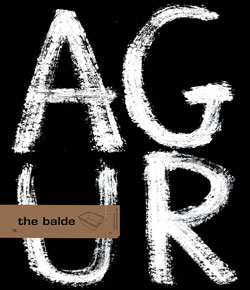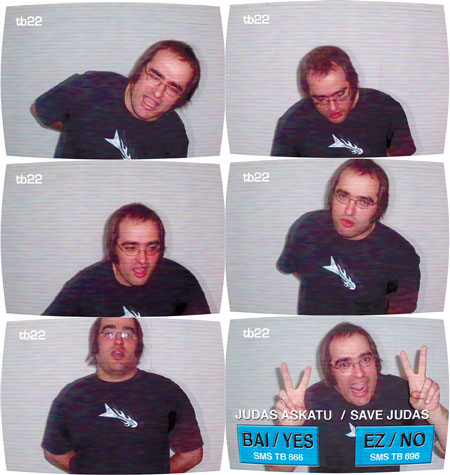get me out of here!
the aesthetics of kidnapping in audio-visual media If we really wanted to, we could write forests about the aesthetics of audio-visuals in kidnapping. However, seeing as the objective of this short essay is not to get our hands on grants or the like, we’ll keep it short and to the point. As regards the technical and aesthetical aspects, there are certain characteristics that are carefully maintained and repeated. The background should be as neutral as possible. A logical security step. At most, only a message by the organisation or that organisation’s symbol should appear, but what the symbol is made of should not be clearly visible.
No clues there.
The image should have a rough texture to it. A camcorder is used to this effect. The reason is simple enough. All cameras leave something like a code on the cassette or the films when they record. There are many more models of camcorders than there are of professional cameras, so it’s virtually impossible to find any leads there. A medium-sized or wide lens is used. It’s ideal for enclosed places, and with the help of appropriate lighting, is used to disfigure the kidnap victim and to make their situation seem all the worse.
It’s important to convey that the victim is in an extreme situation. In addition to the technical aspects involved, the aesthetics of the whole set-up are also very important. The visualisation of the kidnap scene requires very littler onscreen movement and dynamism. It should be static. Keep in mind that these image will be shown on news programmes all across the world. The kidnappers know exactly how much a second of TV time costs. Once they have ensured a contrast between the colours of the background and the clothes the victim is wearing, they must ensure that the person kidnapped stays as still as possible while delivering their message.
What is behind the use of these aesthetics in audio-visual broadcasts of kidnapping? It’s as plain as the nose on your face; get the message across and revolt the viewers. That’s why the kidnap victim’s loneliness, anxiety and helplessness are accentuated. The victim is dominated and annulled as a person. They have no control over their actions or lives. This aesthetic turns the person into a mere object. It’s as if they were up for auction alongside a piece of Chinese porcelain. The existence of a special aesthetic for kidnapping is clearly proved by the evidence we see of it on TV everyday. The plea from the kidnap victim and nomination day on any of the ‘reality shows’ on TV is exactly the same. The turning of the person into a mere object that we mentioned before is applicable in both cases, even though there is obviously a difference as far as freedom is concerned. But technically and aesthetically speaking (the difference in the ethics of the whole thing is also becoming harder and harder to distinguish – but we’ll leave that little debate to the intellectuals), these two forms of "kidnapping" are exactly the same.
No clues there.
The image should have a rough texture to it. A camcorder is used to this effect. The reason is simple enough. All cameras leave something like a code on the cassette or the films when they record. There are many more models of camcorders than there are of professional cameras, so it’s virtually impossible to find any leads there. A medium-sized or wide lens is used. It’s ideal for enclosed places, and with the help of appropriate lighting, is used to disfigure the kidnap victim and to make their situation seem all the worse.
It’s important to convey that the victim is in an extreme situation. In addition to the technical aspects involved, the aesthetics of the whole set-up are also very important. The visualisation of the kidnap scene requires very littler onscreen movement and dynamism. It should be static. Keep in mind that these image will be shown on news programmes all across the world. The kidnappers know exactly how much a second of TV time costs. Once they have ensured a contrast between the colours of the background and the clothes the victim is wearing, they must ensure that the person kidnapped stays as still as possible while delivering their message.
What is behind the use of these aesthetics in audio-visual broadcasts of kidnapping? It’s as plain as the nose on your face; get the message across and revolt the viewers. That’s why the kidnap victim’s loneliness, anxiety and helplessness are accentuated. The victim is dominated and annulled as a person. They have no control over their actions or lives. This aesthetic turns the person into a mere object. It’s as if they were up for auction alongside a piece of Chinese porcelain. The existence of a special aesthetic for kidnapping is clearly proved by the evidence we see of it on TV everyday. The plea from the kidnap victim and nomination day on any of the ‘reality shows’ on TV is exactly the same. The turning of the person into a mere object that we mentioned before is applicable in both cases, even though there is obviously a difference as far as freedom is concerned. But technically and aesthetically speaking (the difference in the ethics of the whole thing is also becoming harder and harder to distinguish – but we’ll leave that little debate to the intellectuals), these two forms of "kidnapping" are exactly the same.



